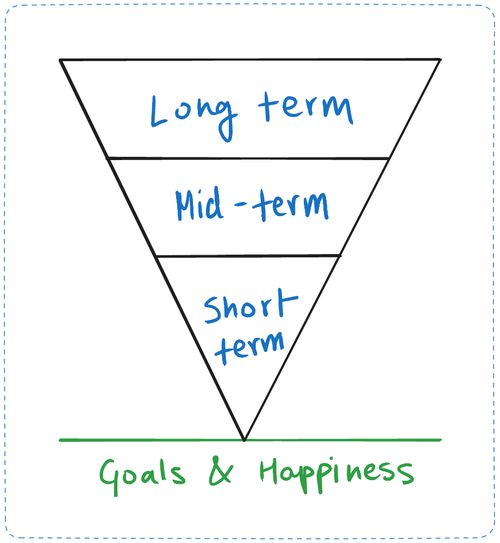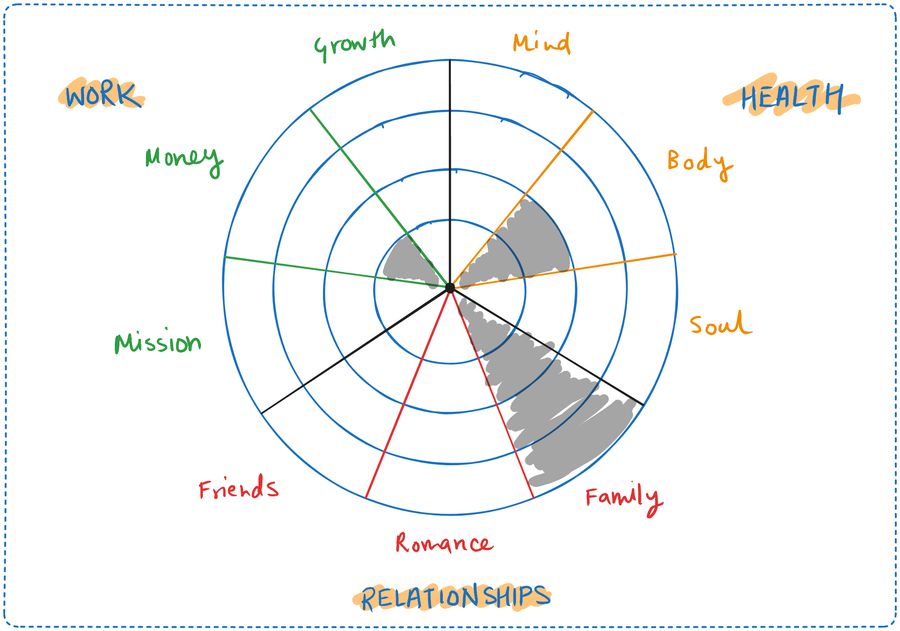Eliminating misalignment burnout
Alignment Practices from Feel-Good Productivity
Burnouts and Misalignment
Many of us experience burnouts. These burnouts can be the result of three factors:
- Overworking
- Improper energy management
- Misalignment
The following practices are to mitigate the third type of burnout: the misalignment burnout.
This happens because we do things that do not resonate with our goals, values and ethics. That can often result in internal conflicts, procrastination and much more. In the end, we end up feeling miserable.
How to solve it?
What we need to do, in general, is:
- Identify your goals, values and ethics.
- Gain Clarity on what actually needs to be done and why based on current situation.
- Do it.
We are going to do that by following this reverse pyramid:

Long-Term (Identification)
5-10 Year Span
In this part, you reflect on the next few years (yes, time travel.)
Eulogy Method
What do you want them to say in your funeral? What would your Eulogy be? Write that down.
Do you want them to say that you were a good person and a good father/mother? Then, it's a sign that you want to align your activities towards that.
Odyssey Plan
What would your life be in the next 5 years if you were following:
- the current path
- an alternate path
- a completely radical path.
For me, the next 5 years in the current path is studying in an uni outside India. In an alternate path, I am toiling in an Indian institute hoping to get a better job placement (this is against my current values). The completely radical path can be to completely drop out of formal education, study on my own and be like Tesla or Pascal.
You may also want to check out Goal Factoring.
After trying these methods, you'll end up with a profound understanding on what your values are and what you need to do to have a better life, in the long term. But it is still vague...
Mid-term (Clarity)
1 Year Span
Alright, you know what you want your future life to be. But what do you do NOW?
In this part, you assess the current situation and get a better understanding of the things you can do in a shorter span of time, to have a better life later.
Wheel of Life
In a nutshell:
- You have 4 concentric circles.
- You divide them into three parts (Health, Relationship, Work), and them into another 3 parts.
- You shade the parts based on how satisfied you are in that particular area.
- The more parts you shade, the more satisfied you are.
Visual Representation:

12-Month Celebration
Imagine yourself 1 year into the future. You're having a catch-up dinner with your best friends and talking about how's life. Think of your achievements in the last 12 months. What did you do?
For me, it's creating 1 video per month on the topics that I like, blogging about the things that I like twice a week, going on a vacation with my family and so on..
This "idealistic" perception will help you know the goals that you want to pursue.
Pre-Mortem
The term "pre-mortem" was originally coined by Gary Klein, and it basically means dissecting before death.
Pre-mortem:
- Gives an idea of what you've neglected
- Legitimises doubts
- Abolishes over-confidence
To oversimplify the process, consider that the plan had failed miserably. And then figure out what could have gone wrong.
So pretty much a pessimistic version of the 12-Month Celebration, but much necessary. You can take the achievements that you thought of in the previous practice, and perform pre-mortem to understand what might go wrong.
This will help you understand what needn't be done. You may also want to check out Planning Fallacy and read Thinking, Fast and Slow.
Short-term (Execution)
Daily-weekly
After all the introspection and reflect, you know your goals, values and ethics and what needs to be done too. But how do we implement it in our day-to-day life?
In this part, you're going to do the things that you really want to do.
Daily Highlights
After performing the Wheel of Life, you must have got an idea of which areas of your life you need to work on.
So each day, pick one task/activity to do for each area of your life, and do it. These activities should be given more priority to other tasks. And be as specific as possible.
For example:
- Work
- Research on starting a tutoring business
- Health
- Start the workout routine
- Relationships
- Call up XYZ
Small changes
Yes, everything compounds.
Start making small changes to your schedule and lifestyle; you can't do everything at once.
Even if you try to better yourself 1% everyday, you'll reap benefits 100x more than if you had not done anything.
Constant Reflection
Make sure to track your progress using a journal or any type of reflection mechanism. And review your long-term and mid-term goals EVERY week. This will help you stay on track, and not forget.
This practice of reflection and reminding yourself is the most important practice in order to do what you really want.
In the end, you'll see that you're much more satisfied with your actions. Sure there maybe some constraints, such as your job, or things like that. I encourage you to research on that, find alternatives, and be a good human.
Happy debugging!
This blogpost is the consolidation of the chapter "Align" from Ali Abdaal's book Feel-Good Productivity. You should read that book.
Continue Reading
Next:
Solitude; or the lack of it
Previous:
What I learned from The Master and Margarita